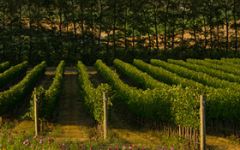Doubleback Cabernet Sauvignon 2019
-
Jeb
Dunnuck -
Robert
Parker -
James
Suckling



Product Details
Your Rating
Somm Note
Winemaker Notes
This vintage was a true testament to the strength of our estate sites. On October 9th a fall frost event wiped out most of Eastern Washington, yet our estate blocks that were still on the vine were in absolutely perfect condition. Deep ruby in color with sexy aromatics. Sandalwood, fresh cherry, undertones of vanilla and pencil shavings are framed by plum and underlying hints of tobacco. The wine is elegant with fine grained tannins but does not sacrifice on full bodied richness - absolutely drinking well now but will age through 2041.
Blend: 87% Cabernet Sauvignon, 6% Merlot, 4% Petit Verdot, 3% Malbec
Professional Ratings
-
Jeb Dunnuck
The 2019 Cabernet Sauvignon is slightly more Cabernet Sauvignon-dominated and checks in as 87% Cabernet Sauvignon, 6% Merlot, 4% Petit Verdot, and 3% Malbec, aged 23 months in a mix of new and neutral French oak. It's another killer wine, offering vibrant crème de cassis, graphite, tobacco leaf, and sappy flower aromas and flavors. Medium to full-bodied, balanced, and elegant, it's straighter and more focused than the Estate Reserve and will benefit from 3-5 years of bottle age and keep for two decades or more.
Rating: 95+
-
Robert Parker's Wine Advocate
Marking the first vintage where they used a full-time vineyard crew, the 2019 Cabernet Sauvignon possesses a generous, juicy frame on the nose with aromas of blackberry, resinous purple flowers and elegant tones. Full-bodied, the mouthfeel is beautifully balanced with impressive weight without being bogged down by a hedonistic alcohol expression. It glides to a gracious and harmonious finish that commands attention. Rating: 94+
-
James Suckling
Aromas of cassis, bark and rosemary. Medium-to full-bodied with silky tannins. Clean and clear ripe fruit with dried herbs on the palate. Straightforward and well made. 87% cabernet sauvignon, 6% merlot, 4% petit verdot and 3% malbec.
Other Vintages
2020-
Jeb
Dunnuck -
James
Suckling -
Robert
Parker - Decanter
-
Jeb
Dunnuck -
Wine
Spectator -
Wine &
Spirits -
James
Suckling -
Robert
Parker
- Decanter
-
Jeb
Dunnuck -
James
Suckling -
Robert
Parker
-
Jeb
Dunnuck - Decanter
-
Wine
Spectator -
James
Suckling -
Wine
Enthusiast -
Robert
Parker
-
Jeb
Dunnuck -
James
Suckling -
Wine
Spectator -
Wine
Enthusiast
-
Robert
Parker -
Wine
Enthusiast
-
Robert
Parker -
Wine
Enthusiast
-
Robert
Parker -
Wine
Spectator -
Wine
Enthusiast
-
Wine
Enthusiast -
Robert
Parker -
Wine
Spectator
-
Wine
Enthusiast -
Robert
Parker -
Wine
Spectator
-
Wine
Spectator -
Robert
Parker -
Wine
Enthusiast
-
Robert
Parker -
Wine
Enthusiast -
Wine
Spectator
-
Wine
Spectator -
Robert
Parker -
Wine
Enthusiast



A noble variety bestowed with both power and concentration, Cabernet Sauvignon enjoys success all over the globe, its best examples showing potential to age beautifully for decades. Cabernet Sauvignon flourishes in Bordeaux's Medoc where it is often blended with Merlot and smaller amounts of some combination of Cabernet Franc, Malbecand Petit Verdot. In the Napa Valley, ‘Cab’ is responsible for some of the world’s most prestigious, age-worthy and sought-after “cult” wines. Somm Secret—DNA profiling in 1997 revealed that Cabernet Sauvignon was born from a spontaneous crossing of Cabernet Franc and Sauvignon Blanc in 17th century southwest France.

Responsible for some of Washington’s most highly acclaimed wines, the Walla Walla Valley has experienced a surge in popularity in recent years and is home to both historic wineries and younger, up-and-coming producers.
The Walla Walla Valley, a Native American name meaning “many waters,” is located in southeastern Washington; part of the appellation actually extends into Oregon. Soils here are well-drained, sandy loess over Missoula Flood deposits and fractured basalt.
It is a region perfectly suited to Rhône-inspired Syrahs, distinguished by savory notes of red berry, black olive, smoke and fresh earth. Cabernet Sauvignon and Merlot create a range of styles from smooth and supple to robust and well-structured. White varieties are rare but some producers blend Sauvignon Blanc with Sémillon, resulting in a rich and round style, and plantings of Viognier, while minimal, are often quite successful.
Of note within Walla Walla, is one new and very peculiar appellation, called the Rocks District of Milton-Freewater. This is the only AVA in the U.S. whose boundaries are totally defined by the soil type. Soils here look a bit like those in the acclaimed Rhône region of Chateauneuf-du-Pape, but are large, ancient, basalt cobblestones. These stones work in the same way as they do in Chateauneuf, absorbing and then radiating the sun's heat up to enhance the ripening of grape clusters. The Rocks District is within the part of Walla Walla that spills over into Oregon and naturally excels in the production of Rhône varieties like Syrah, as well as the Bordeaux varieties.
